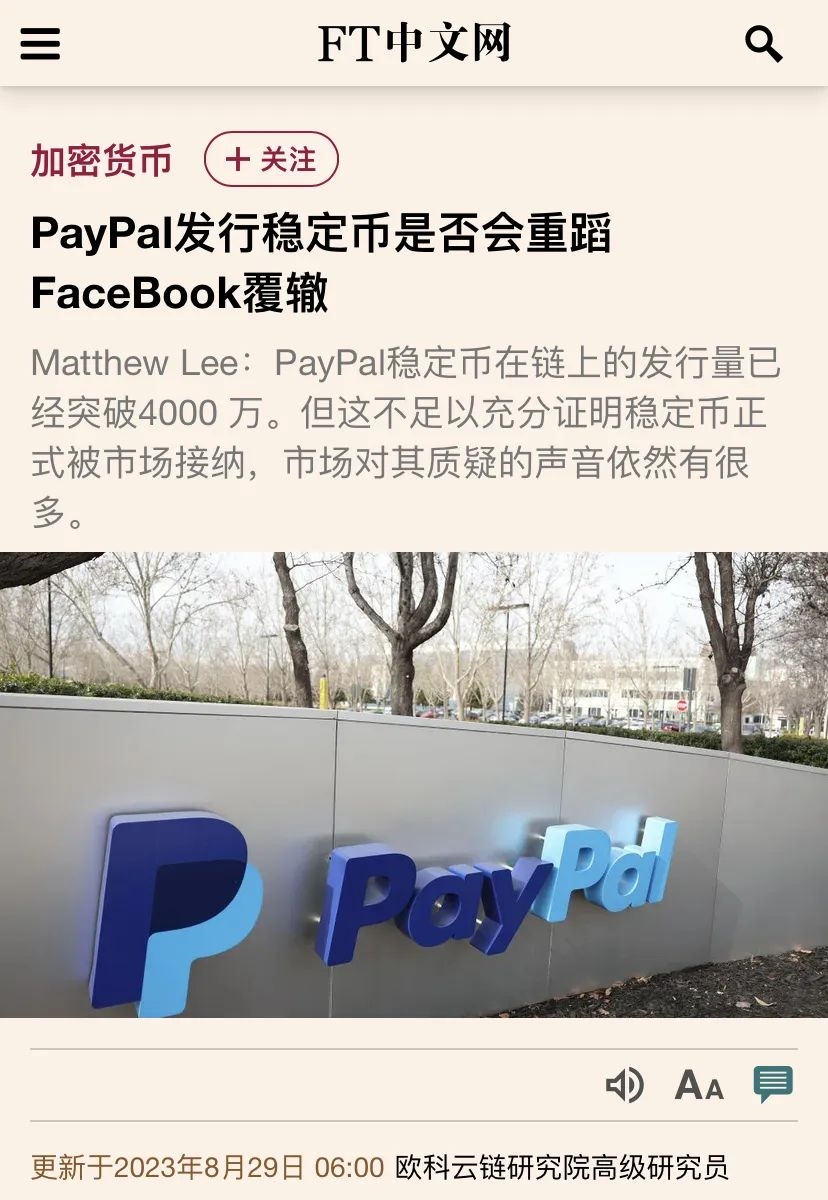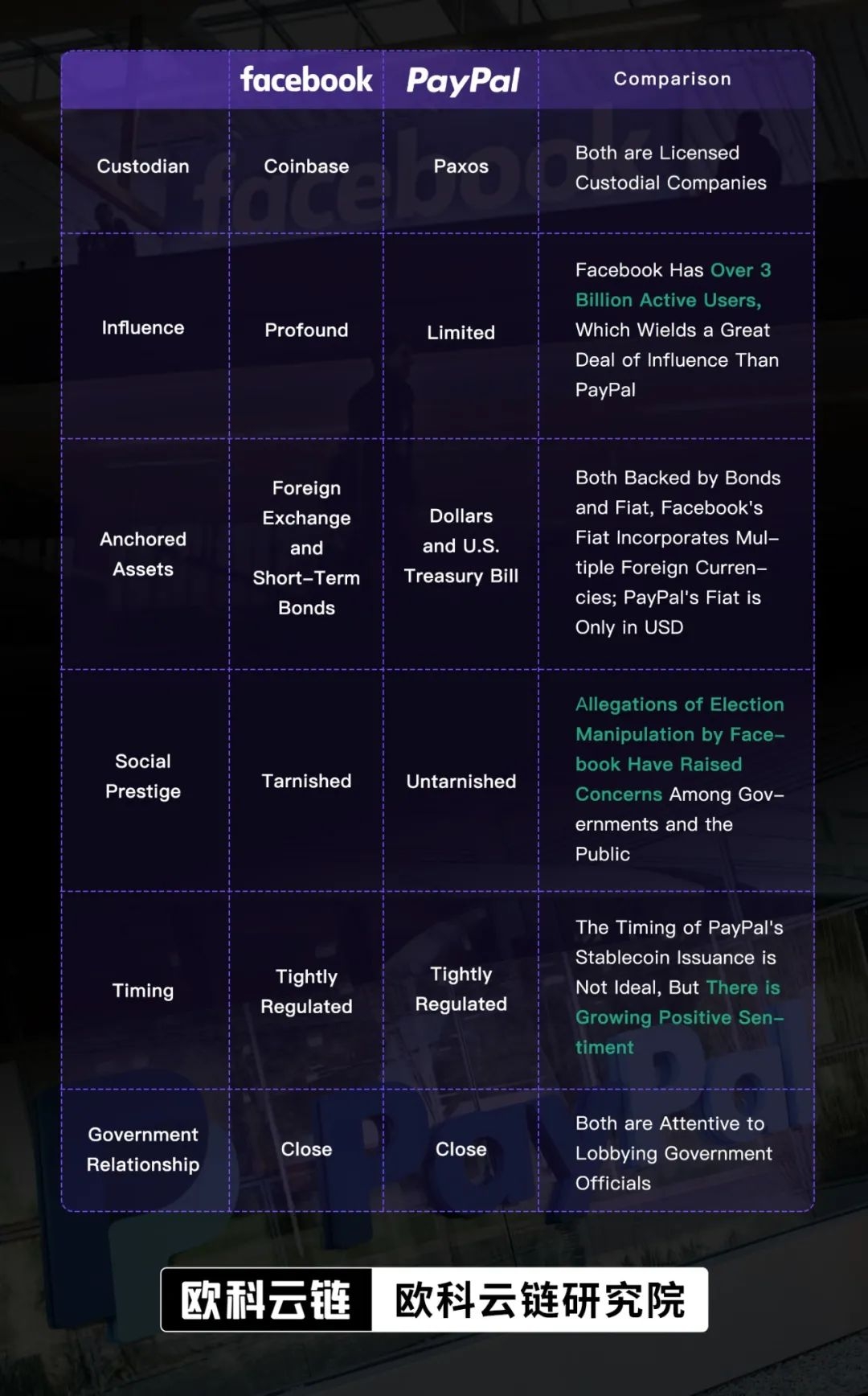The author’s recent report titled “Analyzing Whether the Issuance of Stablecoins by LianGuaiyLianGuail Will Repeat Facebook’s Mistakes” was recently published in the Financial Times (Chinese version) in the UK. Due to the positive response to the report within the European Research Institute of Ouke Cloud Chain, let’s briefly analyze the main content of this report below.

*This article mainly consists of two parts: “Comparative Analysis (deleted)” and “Author’s Viewpoints”. It does not repeat the content already published. If you want to understand the original report in depth, you can read the original article on the FT Chinese website.
- Understanding the Release Process and Functional Updates of Chainlink Staking v0.2 in One Article
- Financial Times How do industry insiders view Grayscale’s victory? How much impact will it have on the future regulation of the US SEC?
- Reviewing the terrifying night of August 18th Who pulled the trigger on the sniper targeting the longs? Which platform’s manipulation was the most obvious?
Produced by: European Research Institute of Ouke Cloud Chain
Author: Matthew Lee
According to the data provided by the European Research Institute of Ouke Cloud Chain, as of August 27, 2023, the issuance of the stablecoin PYUSD by LianGuaiyLianGuail on the blockchain has exceeded 42 million. However, half a month has passed since its first launch, and the current issuance scale is not sufficient to fully prove that the stablecoin has been officially accepted by the market. The experience of the failed issuance of stablecoins as a former strategic partner of Facebook has also cast a shadow over LianGuaiyLianGuail’s strategic adjustment this time.
Therefore, this article mainly compares the issuance of stablecoins by LianGuaiyLianGuail, Circle, and Facebook to discuss the feasibility of LianGuaiyLianGuail’s stablecoin issuance.

The above are the factors that the author has identified as the most likely to affect the issuance of stablecoins. Among them, the author believes that Facebook’s influence and social reputation are two important factors constraining its issuance of stablecoins.
With nearly 3 billion monthly active users, Facebook’s extensive penetration in the field of social media gives it the potential to transform its platform into a global financial institution with billions of users. If Facebook’s stablecoin issuance plan has any loopholes, it could pose a potential threat to global financial stability. Facebook’s reputation has also faced serious challenges. In 2018, it faced widespread social questioning and criticism for allegedly stealing user data to manipulate election results, leading to serious doubts and concerns about its stablecoin plan, and fears that Facebook may once again abuse user data.
Some institutions believe that Facebook’s lobbying of governments and the design mechanism of stablecoins are also factors that have hindered its issuance, but the author does not agree with this. The employees of Facebook’s stablecoin project have backgrounds in middle and high-level government positions, and their political resources are no less than those of LianGuaiyLianGuail. As for the design mechanism of stablecoins, although the anchor assets include foreign currencies other than the US dollar, many people believe that users purchasing Libra will deposit their domestic currency into banks in other countries, directly increasing the circulation of stablecoins and indirectly impacting monetary policy. However, according to the description in its stablecoin whitepaper,

Image source: Libra Whitepaper
Only a small proportion of Facebook’s stablecoin is anchored in cash (with over 50% in USD), most of it is held in short-term bonds, which has a minimal impact on the currency.
How does it compare to Circle’s issuance?
Compared to Facebook, Circle, which was founded in 2013, had a relatively weak background, but its stablecoin launch went much smoother. Apart from the market demand for “compliant” stablecoins at that time, Circle’s determination to enter the stablecoin field was stronger and more “lightweight”.
The following chart shows the important events in Circle’s development:

In the early stages, Circle explored various virtual asset businesses, including exchanges, wallets, payments, and investment banks, among others. Based on the recent development trend of Circle, the company not only abandoned traditional businesses but also eliminated virtual asset businesses other than stablecoins, which helped avoid negative impacts on the financial market.
In addition to changes in business direction, Circle also made significant efforts in compliance. Circle once helped “relevant departments” freeze $100K USDC in blacklisted addresses (as shown in the figure below).

Image source: OKLink Explorer
LianGuaiyLianGuail and Circle share similarities in several aspects. Both are based on payment businesses and have obtained the Virtual Currency and Money Transmitter license from the New York Department of Financial Services (NYDFS). They have a relatively high concentration of business, and compared to Facebook, their influence is limited, with a smaller probability of causing market fluctuations.
Author’s viewpoint
Based on the analysis of Facebook and Circle’s experiences, the author believes that LianGuaiyLianGuail’s stablecoin issuance carries lower potential risks, unlike Facebook’s experience.
During the research process, what surprised the author is that as a traditional payment company, LianGuaiyLianGuail has a very cautious attitude towards on-chain risk control. This strict risk control strategy is likely to become a positive factor in regulatory scrutiny in the future. The following image shows the code for LianGuaiyLianGuail’s stablecoin issuance:

Image source: Bitcoin Twitter account
As can be seen, the highlighted code shows the functions of freezing and unfreezing addresses.
When criminals transfer illegal funds, entities such as LianGuaiyLianGuail, Circle, or exchanges are ultimately involved in the “cash-out” process, so regulating the “cash-out gateways” is one of the important anti-money laundering measures. The lesson from Coinbase, which was fined $50 million by the SEC due to anti-money laundering failures, demonstrates the importance of effective anti-money laundering measures.
Although the compliance teams of Coinbase or Facebook projects have backgrounds in banking, financial technology, and even regulation, they lack understanding of anti-money laundering in blockchain. Their ideas are limited and easily fall into group thinking, focusing on KYC or large transactions as the means to identify money laundering. However, criminals can use various methods to bypass traditional anti-money laundering measures, such as hiring “money mules” and using their accounts as intermediaries to launder money through “withdrawals” from physical companies.
The reality of on-chain anti-money laundering is even more complex. As shown in the figure below, criminals engage in high-frequency transactions to avoid on-chain tracking, although they are eventually captured by the on-chain anti-money laundering tool of OKLink.

LianGuaiyLianGuail’s stablecoin payment gateway will connect merchants and may even expand to Venmo. The difficulty of anti-money laundering is higher than that of exchanges, so LianGuaiyLianGuail also needs stricter compliance control. LianGuaiyLianGuail has also cooperated with on-chain data service providers, purchasing their tag data to monitor gray/blacklisted addresses (including those that interact with sanctioned addresses or are involved in security incidents).
The negligence of many large enterprises in the field of money laundering shows a certain degree of problems, and the anti-money laundering measures of many giants are too perfunctory. However, as regulatory efforts strengthen in various sectors, more and more companies will start to pay attention to this issue.
LianGuaiyLianGuail’s comprehensive preparatory measures further demonstrate its high level of control over operational and regulatory risks.
Like what you're reading? Subscribe to our top stories.
We will continue to update Gambling Chain; if you have any questions or suggestions, please contact us!